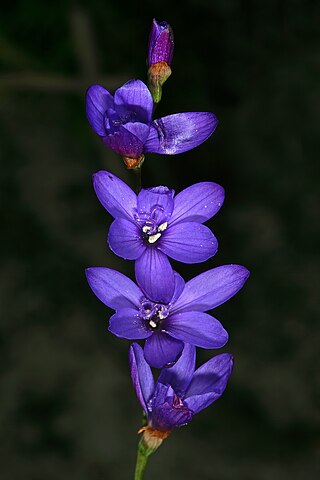
Disa bracteata, also known as the bract disa, leek orchid or the South African weed orchid is a species of orchid native to South Africa.
Nolletia is a genus of flowering plants in the tribe Astereae within the family Asteraceae. The genus was named in honour of Jean-Antoine Nollet, French clergyman and physicist.

Moraea aristata is a species of flowering plant in the family Iridaceae. It is referred to by the common names blue-eyed uintjie or Blouooguintjie in Afrikaans.It is endemic to the city of Cape Town and is considered to be critically endangered.

Geissorhiza aspera, also known as the blue satin flower or blou sysie, is a geophyte from South Africa.

Zyrphelis decumbens is a species of perennial plant from the Bainskloof Mountains in the Cape Provinces of South Africa.
Juncus capillaceus is a rush species native to South America, but has been introduced to other parts of the world.
Senecio ruwenzoriensis is an African species of plant. While it is widely distributed, it seems to be highly localised in this range.
Athanasia pectinata is a species of plant from the Western Cape of South Africa.
Senecio abruptus, or the yellow starvation ragwort, is a species of plant that is endemic to the Cape Provinces of South Africa.

Athanasia quinquedentata, or the fivetooth kanniedood, is a species of plant from South Africa.

Cheiridopsis speciosa is a species of plant from South Africa.
Cheiridopsis schlechteri is a species of plant from South Africa. It is a succulent plant that grows in dry habitats.
Cheiridopsis turbinata is a succulent plant from South Africa.
Osmitopsis parvifolia is a species of plant from South Africa.

Osteospermum spinosum is a species of plant from South Africa.

Nemesia linearis, also known as the witleeubekkie in Afrikaans, is a species of plant from southern Africa. It is found in South Africa and Namibia.
Hebenstretia minutiflora is a species of plant from South Africa. It belongs to the figwort family.

Heliophila africana, the African sunspurge or little blue mouth, is a species of plant from South Africa.

Lachenalia unifolia, the banded viooltjie, is the most common Lachenalia species in the Cape Floristic Region of South Africa.
Lachenalia variegata, also known as the spotty viooltjie, is a species of plant from the Western Cape of South Africa.










